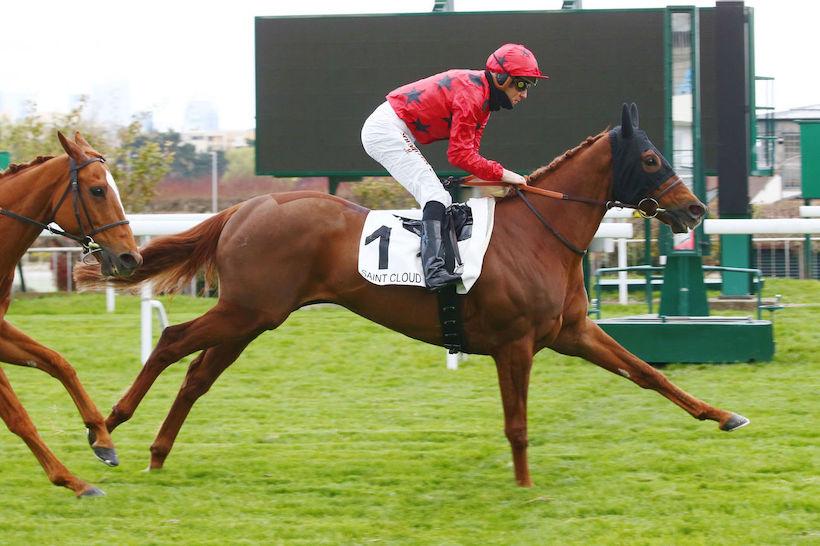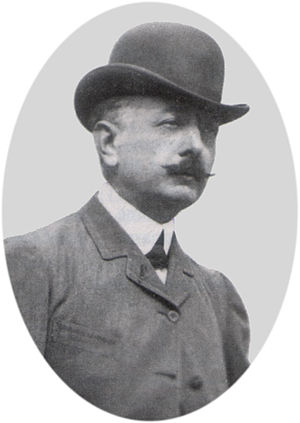A History of the Edmond Blanc: A tribute to the founder of Saint-Cloud

Photo scoopdyga.com
March-April, Saint-Cloud
Prix Edmond Blanc
Group 3, 4-year-olds and above, 1,600m/1m, €80,000
Created in 1921
Last winner: The Revenant, g7 GB, by Dubawi & Hazel Lavery (Excellent Art), owned by Al Asayl France, bred by Al Asayl Bloodstock, trained by Francis-Henri Graffard, ridden by Christophe Soumillon.
Record time: 1’37’’7, Jimmy Two Times in 2017
In 2023, the race will be run for the 94th time
The 2022 edition
Saturday, April 2, 2022, Saint-Cloud Racecourse (Hauts-de-Seine). - The 93rd Prix Edmond Blanc (Gr3) gathered the three first home in the 2021 renewal, namely Wally (Siyouni), Duhail (Lope de Vega) and The Revenant (Dubawi), who’d won in 2019 (the race was cancelled in 2020) and soon went on to become one of Europe’s most successful milers. However, before this third tilt at the race honouring the founder of Saint-Cloud as a training centre and a racecourse, The Revenant had had the opportunity to make his seasonal comeback when winning the Prix Altipan (L) over the same course and distance in impressive fashion, only three weeks prior to this new assignment. On very soft ground, the Francis Graffard-trained, Al Asayl homebred found ideal conditions that were missing a year ago. At the end of a race led fast by Sibila Spain (Frankel), who turned wide in the final bend in search of a faster ground, followed by Océan (Exosphere), The Revenant bid his time but finally stormed home to win quite easily by one length, beating a quite convincing Duhail and Pao Alto (Intello), who was unable to sustain his effort to the post. Sibila Spain bravely held on in 4th, beating Fast Raaj (Iffraaj), fifth, possibly held back on a deep ground unfavourable to sprinters.
The Revenant started his career in Britain and went to Chantilly at Francis Graffard’s yard in September 2018. Since then, he won 12 times out of 17, including the Queen Elizabeth II Stakes (Gr1) at Ascot in September 2020, a year after finishing 2nd in the same Autumn jewel…
He was homebred by Al Asayl, owner of the dam Hazel Lavery (Excellent Art), winner of the St Simon Stakes (Gr3) in England who gave a Kingman filly who’s now run 5 times without success, and an Oasis Dream filly, now 4 and still unraced. Finally, a Saxon Warrior filly was born two years ago.
History
This race was first run in 1921 in memory of Edmond Blanc, one of the most influential French owners and breeders of all time, who died in December 1920. In fact, the first-ever winner of the race was one of his own stock, Le Filon II, in the colours he had made famous (orange jersey, blue cap) and which his widow adopted after his death. Originally open to 3-year-olds and over, as of 1962, the Prix Edmond Blanc was reserved for horses aged 4 and over. Its distance, originally set at 7 ½ furlongs, was lengthened to one mile in 1954. It has always been held at Saint-Cloud, a racecourse founded by Edmond Blanc himself. The race was not held between 1940 and 1945, as the racecourse was closed on account of the war, nor in 1963, 1970 and 1971 when the race was called off due to bad weather. It was also called off in 2020 due to the coronavirus pandemic.
Edmond Blanc (1856-1920)
At the end of the 19th century, Edmond Blanc gave French bloodlines a much-needed boost, enabling its reputation to grow throughout the world and really challenge the supremacy of British breeding.
 When his father, François Blanc, a professional gambler at the casino in Monte Carlo, died in July 1877, Edmond Blanc inherited a great fortune. Using his windfall, this sports enthusiast and accomplished horseman, who already owned a few steeplechasers, bought himself two yearlings. This would turn out to be an astute purchase when one of the two, the filly Nubienne, brought his colours home in the Prix de Diane and the Grand Prix de Paris in 1879. Very soon he became interested in breeding and in 1883 bought the Bel Ebat stud in La Celle-Saint-Cloud and put together some high-quality breeding stock. Soon this stud farm became too small for his needs so Edmond Blanc took on the Villebon stud as well. Next in 1889, he would bring all his breeding stock together at the Jardy estate (in Marnes-la-Coquette), which was transformed into a model stud farm. In 1901, to finally complete his empire, Edmond Blanc had the Saint-Cloud racecourse and the La Fouilleuse yard built, where his horses would henceforth be trained.
When his father, François Blanc, a professional gambler at the casino in Monte Carlo, died in July 1877, Edmond Blanc inherited a great fortune. Using his windfall, this sports enthusiast and accomplished horseman, who already owned a few steeplechasers, bought himself two yearlings. This would turn out to be an astute purchase when one of the two, the filly Nubienne, brought his colours home in the Prix de Diane and the Grand Prix de Paris in 1879. Very soon he became interested in breeding and in 1883 bought the Bel Ebat stud in La Celle-Saint-Cloud and put together some high-quality breeding stock. Soon this stud farm became too small for his needs so Edmond Blanc took on the Villebon stud as well. Next in 1889, he would bring all his breeding stock together at the Jardy estate (in Marnes-la-Coquette), which was transformed into a model stud farm. In 1901, to finally complete his empire, Edmond Blanc had the Saint-Cloud racecourse and the La Fouilleuse yard built, where his horses would henceforth be trained.
Three stallions imported from England would have a far-reaching impact on Edmond Blanc’s breeding stock. First of these was Energy, a horse blessed with great speed, who was imported in 1886 but died prematurely at the age of 10. Next came Winkfield’s Pride (1893), who took the laurels at the Cambridgeshire Handicap and at the Prix du Conseil Municipal. Finally, Flying Fox, who won was one of the few horses to complete the UK Triple Crown in 1899 ( Two Thousand Guinea Stakes, English Derby, St Leger Stakes), was bought by Edmond Blanc at auction in 1900 for a record 37,500 guineas (Nearly 1 million French Francs) from the late Duke of Westminster’s yard. Some thought it to be a risky investment, but nevertheless it was fruitful. Edmond Blanc proved that his audacious investment had indeed been wise a few years later when he sold three of Flying Fox’s progeny as stallions (Adam to the USA, Jardy and Val D’Or to Argentina), for 750 000 Francs each. This outlay also had positive long-term repercussions on the quality of French breeding stock that can be summed up in one name: Teddy - Flying Fox’s grandson via Ajax.
The major horses to run in Edmond Blanc’s colours were Nubienne (1876), Soukaras (1880), Clover (1886), Clamart (1888), Gouverneur (1888), Révérend (1888), Rueil (1889), Gouvernail (1891), Andrée (1892), Arreau (1893), Governor (1897), Saxon (1898), Fer (1899), Caïus (1900), Quo Vadis (1900), Vinicius (1900), Ajax (1901), Gouvernant (1901), Profane (1901), Adam (1902), Génial (1902), Jardy (1902), Val d’Or (1902), Saïs (1903), Ouadi Halfa (1904), Médéah (1905), Union (1906), Marsa (1907), Lord Burgoyne (1908), Porte Maillot (1909) and Dagor (1910).
The number of Group I and II races won by Edmond Blanc’s horses are listed as follows (the name of each Prix is followed by the number of wins) : Cadran 2, Diane 5, Eugène Adam 2, Ganay 3, Grand Critérium 7, Grand Prix de Paris 7, Greffulhe 3, Ispahan 2, Jockey Club 4, Kergorlay 3, Lupin 7, Morny 8, Noailles 3, Poule d’Essai des Poulains 8, Poule d’Essai des Pouliches 3, Robert Papin 6, Royal Oak 3, Vermeille 2, Vicomtesse Vigier 4.
Edmond Blanc also claimed some impressive victories abroad. At the Grand Prix at Baden-Baden in Germany, he won with Vinicius (1903), Gouvernant (1905) and Azalée (1909, dead-heat). In England, he tasted victory in the Eclipse Stakes with Val d’Or (1905) and in the Middle Park Stakes with Gouverneur (1890) and Jardy (1904). But in the English Derby, he had to settle for three runner-up places with Gouverneur (1891), Vinicius (1903) and Jardy (1905).
Three other famous horses are connected to Edmond Blanc’s name: Finasseur (1902), Teddy (1913) and Ksar (1918). Finasseur, sold as a yearling because of having a club foot, went on to win the Prix du Jockey Club and the Grand Prix de Paris for his new owner, Michel Ephrussi. Teddy, sold as a 2-year-old by a disheartened Blanc during the war, proved himself to be the best of his generation while racing in Spain. He then became an extraordinary sire, much to the delight of his owner, J-D Cohn. Finally, Ksar, who the rejuvenated Blanc bought as a yearling at Deauville in 1919 for the then-record price of 151,000F, went on to take the second and third editions of the Prix de L’Arc de Triomphe, after having won fifth place in the Prix du Jockey Club for the orange jersey.
Edmond Blanc’s career can be summarised as follows:
- The public figure. Delegate of the Hautes-Pyrénées (1893-1902), president of the Syndicat des Eleveurs (1906-1920), benefactor of Pau military hospital (1914-1918).
- The sportsman. His horses enjoyed seven victories in the Grand Prix de Paris, taking all three winning places in 1903. He was top in the owners’ rankings seven times, in 1891, 1896, 1901, 1903, 1904, 1905, 1903, and top in the breeders’ rankings eight times, in 1893, 1894, 1897, 1901, 1903, 1904, 1905, 1913.
- His legacy. 1) The breeding stock born at the Jardy and scattered all over the world guarantee the renown of French stockbreeding. 2) Marcel Boussac followed in his footsteps. 3) The Jardy stud and the Saint-Cloud racecourse were still going strong one century after their creation.
Owners
- Marcel Boussac (4 wins): Zariba (1923), Goyescas (1933), Negundo (1935), Goya (1939).
- Jean Stern (4 wins): Sanguinetto (1937), Salieri (1938), Franc Luron (1959, 1960).
- Wertheimers (3 wins): Wolverton (1980) & Val des Bois (1990) for Jacques, and Gold Away (1999) for Wertheimer & Frère.
Trainers
- André Fabre (4 wins): Crystal Glitters (1984), French Stress (1989), Dansili (2000) & Jimmy Two Times (2017).
- Jean-Claude Rouget (4 wins): Skin’s Game (2011), Moonwalk in Paris (2012), Silas Marner (2013), Wally (2021).
- François Mathet (3 wins): Ménétrier (1948), Faubourg (1953) & Afayoon (1975).
- Max Bonaventure (3 wins): Franc Luron (1959, 1960) & Martel (1968)
- Christiane Head (3 wins): Val des Bois (1990), Marathon (1998) & Gold Away (1999).
- John Hammond (3 wins): Polar Falcon (1991), Flag Down (1994) & Kaldounevees (1995).
- Alain de Royer-Dupré (3 wins): Valentino (2005) & Gris de Gris (2009-2010)
Riders
- Christophe Soumillon (6 wins): Bedawin (2002), My Risk (2004), Skin’s Game (2011), Moonwalk in Paris (2012), Stormy Antarctic (2018), The Revenant (2022).
- Charles Elliott (4 wins): Dictateur VIII (1931) Goyescas (1933), Negundo (1935) & Goya (1939).
- Guy Lequeux (3 wins): Manitou III (1950), Orneiro (1952) & Faubourg (1953).
- Léon Flavien (3 wins): Fine Top (1954) & Franc Luron (1959, 1960).
- Jean Deforge (3 wins): Blockhaus (1958), Fin Bec (1961) & Astaria (1965).
- Alfred Gibert (3 wins): Dschingis Khan (1966), In Fijar (1981) & Crystal Glitters (1984).
- Henri Samani (3 victoires): Martel (1968), Sémillant (1969) & Afayoon (1975).
- Freddy Head (3 wins): Wolverton (1980), The Wonder (1982) & Exit to Nowhere (1992)
- Cash Asmussen (3 wins): French Stress (1989), Polar Falcon (1991) & Kaldounevees (1995).
- Olivier Doleuze (3 wins): Wavy Run (1996), Marathon (1998) & Gold Away (1999).
- Gérald Mossé (3 wins): Flag Down (1994), Gris de Gris (2009) & Sommerabend (2014).